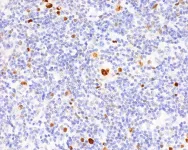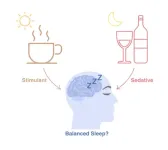(Press-News.org) Hodgkin’s lymphoma is one of the most common types of lymphoma in young adults. It is characterized by the presence of enlarged B lymphocytes, which are unusual in that they bear on their surface the identifying markers of many other immune cells – such as those found on phagocytes, dendritic cells, or T cells. Now, a team led by Stephan Mathas from the Experimental and Clinical Research Center (ECRC) has explained how these changes take place in the cells and what impact they have. The ECRC is a joint institution of the Max Delbrück Center and Charité – Universitätsmedizin Berlin.
“Many different molecular changes have been identified in classic Hodgkin’s lymphoma, but we know little about the mutations that actively promote tumor cell development,” says Stephan Mathas, last author of the study published in “Nature Communications.” Together with colleagues at the Institutes of Human Genetics of the Ulm University Medical Center (Prof. Reiner Siebert) and of the Polish Academy of Sciences in Poznan (Dr. Maciej Giefing), his team trawled through vast amounts of gene sequencing and expression data in search of activating mutations. In cell lines and later in patient tumor cells, they repeatedly found the same mutation in the transcription factor IRF4 in about 15 percent of patients.
Completely changed functionality
“In these cases, within IRF4 only one amino acid has been altered: IRF4 contains an arginine instead of a cysteine at position 99,” explains Mathas. “In collaboration mainly with Pierre Cauchy and Constanze Bonifer from Birmingham in the United Kingdom, we showed that this completely changes how the transcription factor functions: It can no longer bind to its usual DNA binding sites, but instead binds to other DNA motifs that are not normally recognized. This fundamentally modifies the regulation of gene activity.” As a consequence, B lymphocytes are prevented from maturing into antibody-producing plasma cells.
Since this mutation is common in Hodgkin’s patients, the researchers suspected that it may be advantageous to tumor cells. So they decided to generate healthy B cells capable of producing both the “normal” and altered IRF4 and then to analyze which genes are regulated by the mutant. When the IRF4-C99R mutant was turned on, the healthy plasma cell program remained silent. Instead, it resulted in the upregulation of genes commonly associated with Hodgkin’s lymphoma – genes that, in their healthy state, cannot be turned on at all by IRF4.
Irregular docking activity
The comparatively bulky arginine of the IRF4-C99R mutant no longer fits into the usual DNA docking sites, but it does bind well to other sites on the DNA. This results in the activation of disease-relevant genes.
“A key finding for us was that a point mutation can lead to both a loss and an increase in DNA binding ability, and thus has fundamental consequences for gene function,” says Dr. Nikolai Schleußner, co-first author of the study along with Pierre Cauchy. Such changes at DNA binding sites are difficult to predict using bioinformatics techniques. That is why, says Schleußner, it was so important to combine experimental work with innovative bioinformatics analyses by researchers in Birmingham, Vancouver, and at MDC-BIMSB in Berlin.
A previous study by Mathas’s team and international collaborators, published in January 2023 in “Science Immunology,” had already shown that changing a single amino acid in this transcription factor can have big consequences. During that research, the scientists discovered an IRF4 mutation located only a few amino acids away that causes a severe, previously unknown immunodeficiency in children. “We believe we have described a mechanism that also plays a key role in other diseases,” stresses Mathas.
Searching for inhibitors
The current study suggests it may be possible to block the misdirected activation of a transcription factor. “Today it is difficult to directly block transcription factors. But now that we know where the mutant binding sites are, we can look for inhibitors that occupy precisely these DNA binding pockets while leaving healthy cells untouched,” says Mathas.
Max Delbrück Center
The Max Delbrück Center for Molecular Medicine in the Helmholtz Association (Max Delbrück Center) is one of the world’s leading biomedical research institutions. Max Delbrück, a Berlin native, was a Nobel laureate and one of the founders of molecular biology. At the locations in Berlin-Buch and Mitte, researchers from some 70 countries study human biology – investigating the foundations of life from its most elementary building blocks to systems-wide mechanisms. By understanding what regulates or disrupts the dynamic equilibrium of a cell, an organ, or the entire body, we can prevent diseases, diagnose them earlier, and stop their progression with tailored therapies. Patients should benefit as soon as possible from basic research discoveries. The Max Delbrück Center therefore supports spin-off creation and participates in collaborative networks. It works in close partnership with Charité – Universitätsmedizin Berlin in the jointly run Experimental and Clinical Research Center (ECRC), the Berlin Institute of Health (BIH) at Charité, and the German Center for Cardiovascular Research (DZHK). Founded in 1992, the Max Delbrück Center today employs 1,800 people and is funded 90 percent by the German federal government and 10 percent by the State of Berlin.
END
Hodgkin’s lymphoma: Small change, big effect
2023-11-08
ELSE PRESS RELEASES FROM THIS DATE:
How animals get their stripes and spots
2023-11-08
Nature has no shortage of patterns, from spots on leopards to stripes on zebras and hexagons on boxfish. But a full explanation for how these patterns form has remained elusive.
Now engineers at the University of Colorado Boulder have shown that the same physical process that helps remove dirt from laundry could play a role in how tropical fish get their colorful stripes and spots. Their findings were published Nov. 8 in the journal Science Advances.
“Many biological questions are fundamentally ...
A fifth of European Red List flora and fauna species may be at risk of extinction
2023-11-08
A new analysis of 14,669 threatened species of plants and animals found in Europe reveals that about one fifth face the risk of extinction, and that agricultural land-use change poses a significant threat to these species. Axel Hochkirch of the Musée National d’Histoire Naturelle, Luxembourg, and colleagues present these findings in the open-access journal PLOS ONE on November 8, 2023.
The variety of species of living things—biodiversity—is declining around the world, as more and more species face the risk of extinction. Many efforts, including some by governments and nonprofit organizations, aim to reduce the loss ...
Head lice evolution mirrors human migration and colonization in the Americas
2023-11-08
A new analysis of lice genetic diversity suggests that lice came to the Americas twice – once during the first wave of human migration across the Bering Strait, and again during European colonization. Marina Ascunce, currently at the USDA-ARS, and colleagues, report these findings in a new study published November 8 in the open-access journal PLOS ONE.
The human louse is a wingless, blood-sucking parasite that lives its entire life on its host. It is one of the oldest known parasites to live on humans, and the two species have coevolved ...
A digital detox may not improve wellbeing: social media users who reduced their use for a week saw decreases in positive emotions as well as in negative ones
2023-11-08
A digital detox may not improve wellbeing: social media users who reduced their use for a week saw decreases in positive emotions as well as in negative ones
###
Article URL: https://journals.plos.org/plosone/article?id=10.1371/journal.pone.0293467
Article Title: Restricting social networking site use for one week produces varied effects on mood but does not increase explicit or implicit desires to use SNSs: Findings from an ecological momentary assessment study
Author Countries: UK
Funding: This work was supported by the Economic and Social Research ...
Financial traders may seek better sleep by self-medicating with caffeine and alcohol to balance the effects of the stimulant and the sedative, per micro-longitudinal study
2023-11-08
Financial traders may seek better sleep by self-medicating with caffeine and alcohol to balance the effects of the stimulant and the sedative, per micro-longitudinal study
###
Article URL: https://journals.plos.org/plosone/article?id=10.1371/journal.pone.0291675
Article Title: Sleep, alcohol, and caffeine in financial traders
Author Countries: USA
Funding: The authors received no specific funding for this work. END ...
Autism brain states hold the key to unlocking childhood memories
2023-11-08
Neuroscientists have discovered a fascinating connection between the retention of early life memories and brain developmental trajectories associated with autism [Wednesday 8th November 2023].
Most of us remember little of our experiences from before two years of age. This form of memory loss, termed “infantile amnesia” refers to the seemingly complete loss of episodic and autobiographical memories formed during early life. The research team at Trinity College Dublin investigated how infantile amnesia is affected by forms of autism.
The maternal immune response, sparked into life in response to infection during pregnancy, ...
Artificial bladders shine light on bugs that cause urinary tract infections
2023-11-08
The research, published today in Science Advances, is the first to use a sophisticated human tissue model to explore the interaction between host and pathogen for six common species that cause urinary tract infections. The findings suggest that the ‘one size fits all’ approach to diagnosis and treatment currently used in most healthcare systems is inadequate.
Urinary tract infection (UTI) is a growing problem, with around 400 million global cases per year and an estimated 250,000 UTI-related deaths associated with antimicrobial resistance ...
Temperature increase triggers the viral infection
2023-11-08
Researchers at Lund University, together with colleagues at the NIST Synchrotron Facility in the USA, have mapped on an atomic level what happens in a virus particle when the temperature is raised.
"When the temperature rises, the virus's genetic material changes its form and density, becoming more fluid-like, which leads to its rapid injection into the cell," says Alex Evilevitch a researcher at Lund University who led the study.
Viruses lack their own metabolism and the ability to replicate independently; they are entirely dependent on a host cell to multiply. Instead, the virus hijacks the internal machinery of the infected cell ...
Molecule tested at University of São Paulo, in Brazil, proves able to mitigate heart failure
2023-11-08
Researchers at the University of São Paulo (USP) in Brazil, partnering with Foresee Pharmaceuticals, a Taiwan and US-based biopharmaceutical company, have tested a synthetic molecule for the treatment of heart failure. The study, funded by FAPESP, was published yesterday (11/07/2023) in the European Heart Journal. The theme was also highlighted in the magazine's editorial.
Heart failure is a condition in which the heart muscle cannot pump enough blood to meet the body's needs for blood and oxygen. It causes more deaths worldwide than any other disease, in the sense that other cardiovascular disorders ...
How mice choose to eat or to drink
2023-11-08
Making decisions is hard. Even when we know what we want, our choice often leaves something else on the table. For a hungry mouse, every morsel counts. But what if the decision is more consequential than choosing between crumbs and cheese?
Stanford researchers investigated how mice resolve conflicts between basic needs in a study published in Nature on Nov. 8. They presented mice that were both hungry and thirsty with equal access to food and water and watched to see what happened next.
The behavior of the mice surprised the scientists. Some gravitated first ...





